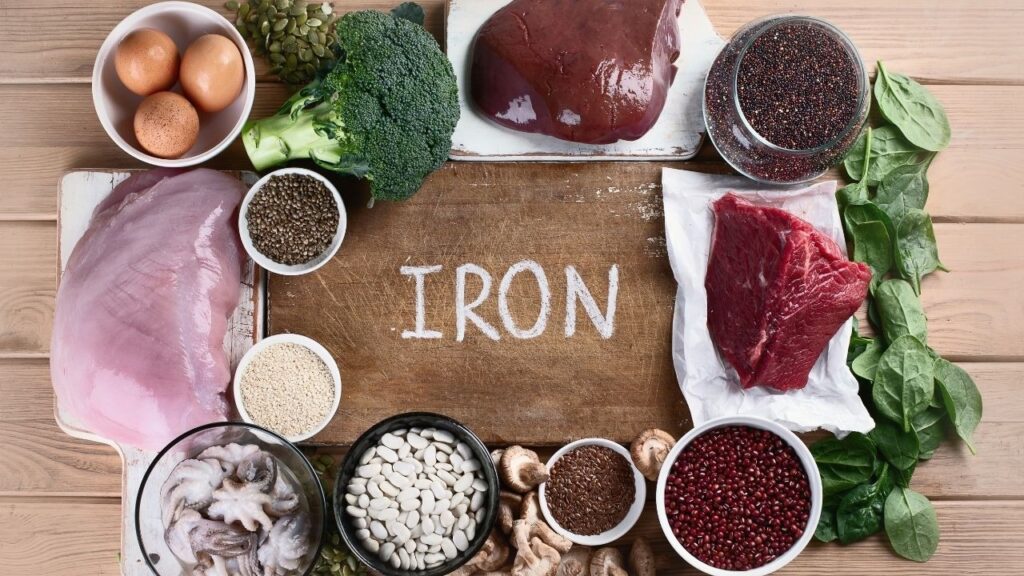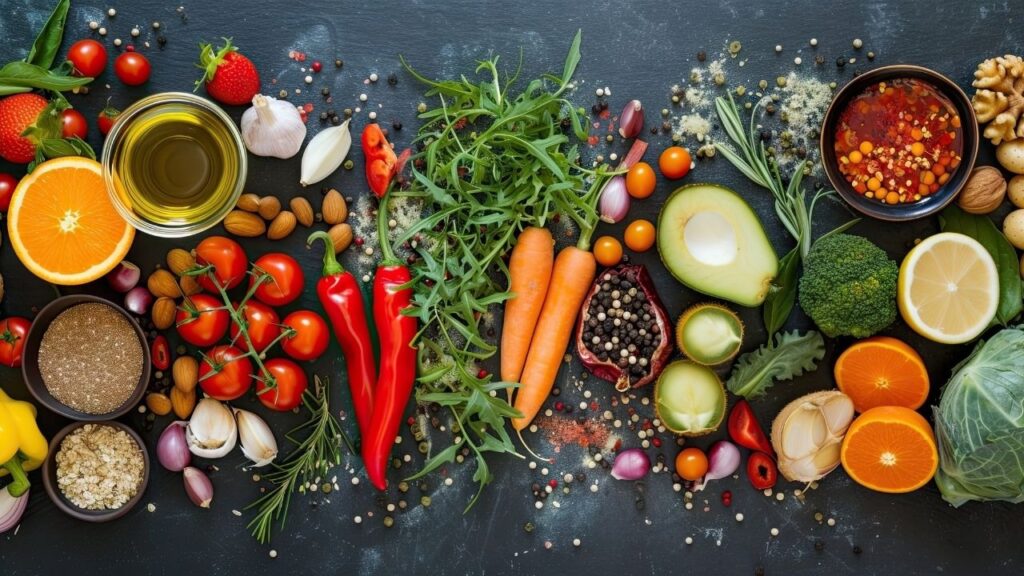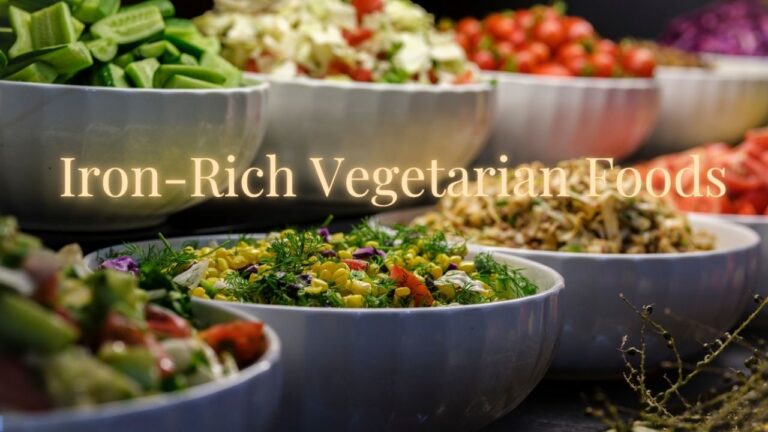Do you wake up tired even after a full night’s sleep? Or feel like you’re running on empty halfway through the day? If so, you’re not alone. Fatigue is one of the most common health complaints, and one sneaky culprit could be low iron levels—especially for vegetarians.
Iron is essential for producing hemoglobin, the protein in red blood cells that carries oxygen throughout your body. Without enough iron, your cells don’t get the oxygen they need, leaving you feeling sluggish, weak, and mentally foggy.
But here’s the good news: you don’t need to eat meat to get your iron fix. There are plenty of iron-rich vegetarian foods that can help you boost your energy levels, improve focus, and feel like yourself again.
In this post, we’ll break down the best vegetarian sources of iron, how to maximize absorption, and easy meal ideas to keep you powered up all day long.

Understanding Iron and Why It Matters
Iron isn’t just another mineral—it’s the body’s energy enabler. It helps in forming hemoglobin and myoglobin, both of which transport oxygen to your muscles and tissues. Without enough of it, your organs struggle to function efficiently.
Common symptoms of iron deficiency include:
- Constant tiredness or fatigue
- Pale skin
- Shortness of breath
- Cold hands and feet
- Dizziness or headaches
- Brittle nails and hair loss
If you’re vegetarian or vegan, you’re more at risk because plant-based iron—called non-heme iron—is not as easily absorbed by the body as heme iron (from animal sources). But with the right food combinations and cooking strategies, you can absolutely meet your iron needs through a vegetarian diet.
How Much Iron Do You Really Need?
The recommended daily intake (RDI) for iron varies depending on age, gender, and lifestyle:
| Group | Recommended Daily Iron Intake |
| Adult Men | 8 mg |
| Adult Women (19–50 years) | 18 mg |
| Pregnant Women | 27 mg |
| Postmenopausal Women | 8 mg |
| Vegetarians | Up to 1.8x higher (because of lower absorption rates) |
Since plant-based iron is absorbed less efficiently, vegetarians should aim for about 14–32 mg daily, depending on individual needs.

Best Iron-Rich Vegetarian Foods to Boost Energy
Let’s dive into the foods that can naturally restore your energy levels and help you fight fatigue—without touching meat.
1. Lentils: The Vegetarian Powerhouse
Lentils are one of the richest vegetarian sources of iron, offering around 6.6 mg per cooked cup. They’re also packed with protein, fiber, and folate, making them a staple in vegetarian diets.
Why they’re great:
- Improve red blood cell production
- Keep blood sugar levels stable
- Support muscle recovery after exercise
How to eat more:
- Add them to soups, stews, or curries
- Make a hearty lentil salad with spinach and roasted vegetables
- Prepare lentil patties for a protein-packed snack
2. Spinach: The Classic Iron Booster
Spinach might not turn you into Popeye overnight, but it’s still an iron superstar. One cooked cup provides around 6.4 mg of iron.
Pro tip: Iron from spinach is non-heme, so pair it with vitamin C-rich foods like tomatoes, bell peppers, or lemon juice to enhance absorption.
Easy ideas:
- Toss spinach into your smoothies
- Add it to omelets or pasta
- Make a warm spinach and chickpea stir-fry
3. Chickpeas: The Energy Bean
Chickpeas (garbanzo beans) are versatile, delicious, and full of nutrients—one cup gives you 4.7 mg of iron.
Why they’re perfect for vegetarians:
- Great source of plant-based protein
- High in fiber to keep you full
- Promote stable energy levels
Ways to enjoy:
- Make hummus for a healthy snack
- Roast chickpeas for a crunchy treat
- Add them to curries, salads, or grain bowls
4. Tofu and Tempeh: Plant-Based Protein with a Punch
Derived from soybeans, both tofu and tempeh are iron-rich and protein-dense. A ½ cup of tofu provides about 3.4 mg of iron, while tempeh packs around 4.5 mg.
Why they stand out:
- Provide all essential amino acids
- Contain calcium and magnesium
- Great for muscle repair and hormone balance
Delicious ideas:
- Stir-fry tofu with broccoli and bell peppers
- Add tempeh to sandwiches or wraps
- Try marinated tofu in grain bowls
5. Pumpkin Seeds: Small but Mighty
Pumpkin seeds (pepitas) are an iron-rich snack powerhouse. Just ¼ cup offers 2.5 mg of iron, along with zinc, magnesium, and healthy fats.
Why they’re a smart snack:
- Boost energy and concentration
- Support healthy immune function
- Easy to sprinkle on almost anything
Quick snack tips:
- Add to oatmeal, smoothies, or salads
- Mix with nuts and dried fruit for a DIY trail mix
- Sprinkle over roasted veggies or yogurt
6. Quinoa: The Complete Protein Grain
Quinoa isn’t just trendy—it’s also a great iron source, providing 2.8 mg per cooked cup. It’s gluten-free, high in protein, and contains all nine essential amino acids.
Why quinoa works:
- Steady energy release
- Packed with fiber and antioxidants
- Great alternative to rice or pasta
How to enjoy:
- Use as a base for Buddha bowls
- Add to soups and salads
- Make quinoa breakfast porridge with berries and nuts
7. Black Beans: Iron and Fiber in Every Bite
Black beans contain around 3.6 mg of iron per cup and are known for improving gut health and supporting steady energy.
Ways to include more:
- Add to tacos or burrito bowls
- Mix into soups and stews
- Make black bean burgers or chili
8. Dark Chocolate: The Sweet Iron Treat
Yes, you can eat chocolate and boost your iron! Dark chocolate (70–85% cocoa) has about 3.3 mg of iron per ounce.
Why it’s a guilt-free indulgence:
- Loaded with antioxidants
- Enhances mood and energy
- Helps curb sugar cravings
Enjoy responsibly:
- Eat a small square after meals
- Add cocoa nibs to oatmeal or smoothies

How to Improve Iron Absorption Naturally
Getting enough iron is one thing—but helping your body absorb it efficiently is just as important.
Smart tips to maximize absorption:
- Pair iron with vitamin C: Eat citrus fruits, tomatoes, or bell peppers with your meals.
- Avoid tea and coffee around meals: They contain tannins that block iron absorption.
- Cook in cast iron pans: This can increase the iron content of your food naturally.
- Soak or sprout legumes and grains: Reduces phytates that inhibit absorption.
Sample One-Day Iron-Rich Vegetarian Meal Plan
| Meal | Food | Iron (mg) |
| Breakfast | Spinach and tofu scramble + orange juice | 8.0 |
| Snack | Pumpkin seeds and dark chocolate | 3.0 |
| Lunch | Lentil and quinoa salad with bell peppers | 9.0 |
| Snack | Hummus with carrot sticks | 2.5 |
| Dinner | Chickpea curry with brown rice | 7.0 |
| Total Iron Intake: | – | 29.5 mg |
With a few simple tweaks, you can easily hit your daily iron goals—without supplements or animal products.
Other Nutrients That Support Iron Absorption
Iron doesn’t work alone. Your body needs several nutrients to optimize its use:
- Vitamin C: Boosts non-heme iron absorption
- Folate & B12: Support red blood cell formation
- Copper & Zinc: Help release stored iron
- Protein: Enhances transport and utilization
Including a variety of fruits, vegetables, nuts, and whole grains ensures you’re covering all nutritional bases.
When to Consider Iron Supplements
If you’re still feeling tired despite a balanced vegetarian diet, it might be worth checking your iron levels with a blood test. Low ferritin or hemoglobin levels could indicate deficiency.
Before starting any supplement, consult your doctor. Too much iron can lead to toxicity, especially if taken unnecessarily. Always prioritize food first whenever possible.
Conclusion: Reclaim Your Energy Naturally
If constant tiredness has become your norm, it’s time to look at what’s on your plate. Adding iron-rich vegetarian foods like lentils, spinach, tofu, and quinoa can make a huge difference in how energized and focused you feel.
Small, consistent dietary changes can restore your vitality, boost immunity, and help you perform at your best—naturally and sustainably.
So, next time you feel that afternoon slump coming on, skip the coffee and reach for an iron-powered snack instead. Your body (and brain) will thank you.


